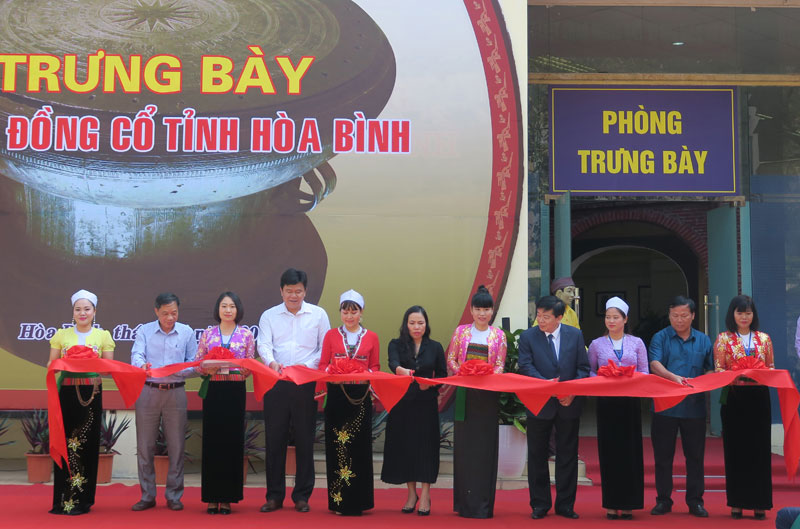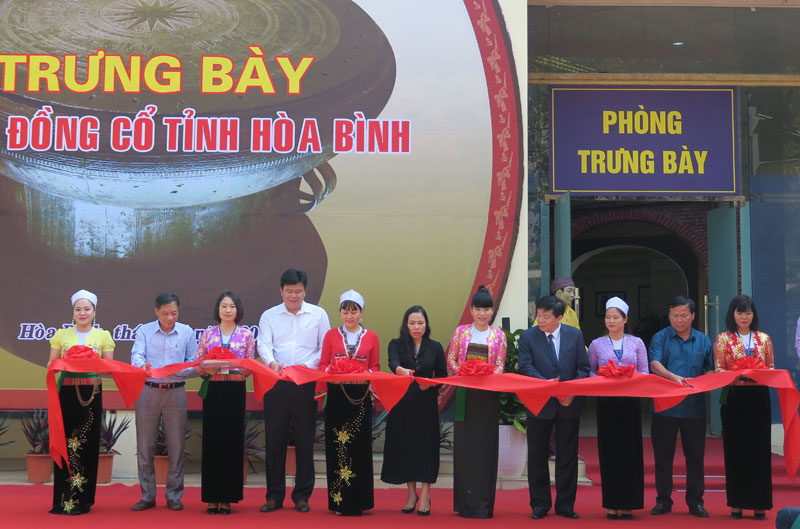
(HBO) – The Hoa Binh Department of Culture, Sports and Tourism recently launched an exhibition on antique bronze drums found in the province. The opening ceremony was attended by Vice Chairman of the provincial People’s Committee Nguyen Van Chuong along with representatives from some departments and sectors, and over 100 students across Hoa Binh city.
 Nguyen
Van Chuong, Vice Chairman of the provincial People’s Committee and other
delegates cut the ribbon to kick off the exhibition.
Nguyen
Van Chuong, Vice Chairman of the provincial People’s Committee and other
delegates cut the ribbon to kick off the exhibition.
Bronze drums are treasures left by ancestors since
the nation’s foundation. The Dong Son culture dated back to the first century
BC was seen as the most brilliant period of development of bronze drums in
Vietnam. So far over 1,000 bronze drums have been found, mainly in northern
provinces.
In Hoa Binh alone, the cradle of Hoa Binh
culture, more than 100 ancient bronze drums of all kinds have been uncovered,
ranking second nationwide in the number, after the north central province of
Thanh Hoa.
Ancient bronze drums in Hoa Binh are mainly of
the Heger II type (over 90 percent). They are dated from the first century to
the 17th century.
The drums were discovered in almost all
districts in the province. Apart from some drums found in ancient Muong tombs,
the remainder was mainly uncovered by chance when locals dug ditches or built houses
and roads.
On display at the provincial museum were nearly
200 documents and objects featuring the origin and values of ancient bronze
drums.
The exhibition is one of the activities to
welcome the Hoa Binh culture-tourism week 2019 with the aim of introducing the
local bronze drums and unique culture of ethnic groups in the province./.
With an increasingly vibrant and widespread emulation movement aimed at building cultured residential areas and cultured families, Yen Thuy District has been making steady progress toward improving both the material and spiritual well-being of its people, while fostering a civilized, prosperous, beautiful, and progressive community.
Once lacking recreational spaces and community facilities, Residential Group 2 in Quynh Lam Ward (Hoa Binh City) has recently received attention for the construction of a new, spacious, and fully equipped cultural house. The project followed the model of state support combined with public contributions in both labor and funding.
The "All people unite to build cultural life" movement, which has been effectively integrated with Kim Boi district’s socio-economic development goals, is fostering a lively spirit of emulation across local residential areas, hamlets, villages, public agencies, and enterprises. In addition, through the initiative, traditional cultural values are being preserved and promoted, while community solidarity and mutual support in poverty reduction and economic development are being strengthened.
A working delegation of the Hoa Binh provincial People’s Committee led by its Permanent Vice Chairman Nguyen Van Toan on June 11 inspected the progress of a project to build the Mo Muong Cultural Heritage Conservation Space linked to tourism services in Hop Phong commune, Cao Phong district.
Born and growing in the heroic land of Muong Dong, Dinh Thi Kieu Dung, a resident in Bo town of Kim Boi district, in her childhood was nurtured by the sweet lullabies of her grandmother and mother. These melodies deeply imprinted on her soul, becoming an inseparable part of her love for her ethnic group's culture. For over 20 years, this love for her hometown has driven Dung to research, collect, and pass down the cultural values of the Muong people to future generations.
In the final days of May, the Ethnic Art Troupe of Hoa Binh Province organized performances to serve the people in remote, mountainous, and particularly disadvantaged areas within the province. These were not just ordinary artistic shows, but they were the meaningful journeys aimed at spreading cultural values, enhancing the spiritual life of the people and contributing to the preservation of ethnic minority cultural identities.



 Nguyen
Van Chuong, Vice Chairman of the provincial People’s Committee and other
delegates cut the ribbon to kick off the exhibition.
Nguyen
Van Chuong, Vice Chairman of the provincial People’s Committee and other
delegates cut the ribbon to kick off the exhibition.